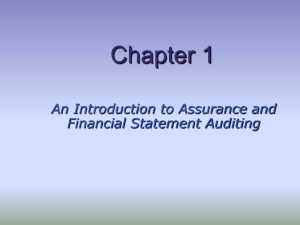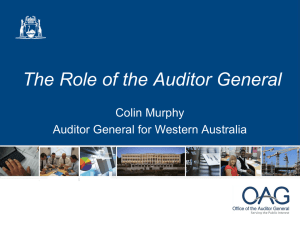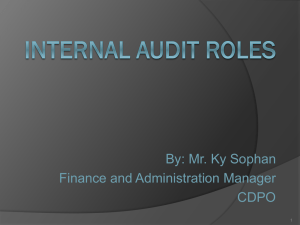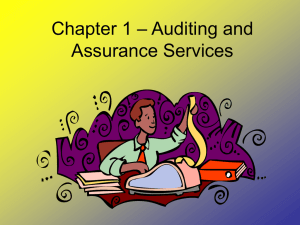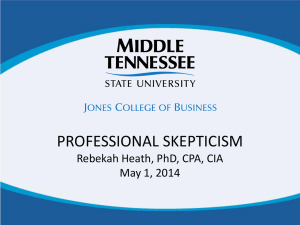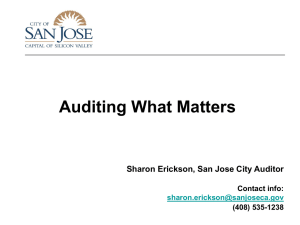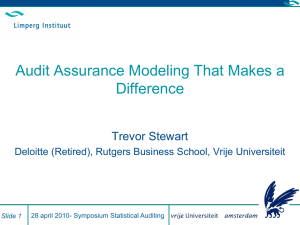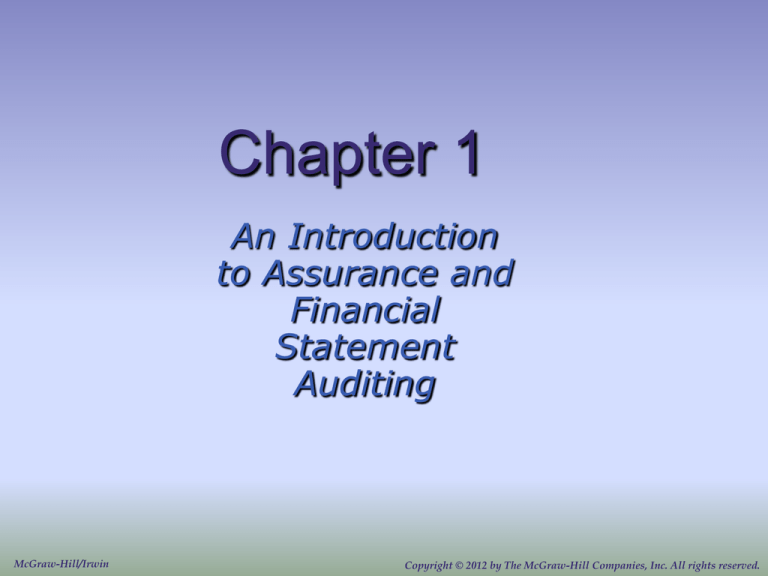
Chapter 1
An Introduction
to Assurance and
Financial
Statement
Auditing
McGraw-Hill/Irwin
Copyright © 2012 by The McGraw-Hill Companies, Inc. All rights reserved.
LO# 1
The Study of Auditing
The study of auditing is different from other accounting
courses that you have taken in college because …
OTHER COURSES
Rules,
techniques and
computations to
prepare and
analyze financial
information
AUDITING
Analytical and
logical skills
Much more
conceptual in
nature
1-2
LO# 2
The Demand for Auditing
and Assurance
The development of the corporate form of
business and the expanding world economy
over the last 200 years have given rise to
an explosion in the demand for assurance
provided by auditors.
1-3
LO# 2
Principals and Agents
A public company is a company that sells its stocks or
bonds to the public, giving the public a valid interest in
the proper use, or stewardship, over the company’s
resources.
Managers
Stockholders
Agents
Principals
1-4
The Role of Auditing
LO# 2
Figure 1-1 Overview of the Principal-Agent Relationship Leading to the Demand for Auditing
1-5
LO# 4
Relationships among Auditing,
Attest, and Assurance Services
1-6
LO# 5
Auditing, Attest, and Assurance
Services Defined
Auditing
Attest
Assurance
Services
A systematic process of objectively
obtaining and evaluating evidence
regarding assertions about economic
actions and events to ascertain the
degree of correspondence between
those assertions and established
criteria and communicating the results
to interested users.
1-7
LO# 5
Auditing, Attest, and Assurance
Services Defined
Auditing
Attest
Assurance
Services
Attest services occur when a
practitioner is engaged to issue ... a
report on subject matter, or an
assertion about subject matter, that is
the responsibility of another party.
1-8
LO# 5
Auditing, Attest, and Assurance
Services Defined
Auditing
Attest
Assurance
Services
Independent professional services that
improve the quality of information, or
its context, for decision makers.
1-9
LO# 6
Overview of the Financial
Statement Audit Process
1-10
LO# 6
Fundamental Concepts in
Conducting a Financial Statement
Audit
Materiality
Audit
Risk
Evidence
1-11
LO# 6
Materiality
Materiality is the magnitude of an
omission or misstatement of
accounting information that, in
light of surrounding
circumstances, makes it probable
that the judgment of a reasonable
person relying on the information
would have been changed or
influenced by the omission or
misstatement.
1-12
LO# 6
Audit Risk
Audit risk is the risk that the auditor may
unknowingly fail to appropriately modify his or her
opinion on financial statements that are materially
misstated.
The auditor’s standard
report states that the audit
provides only reasonable
assurance that the
financial statements do not
contain material
misstatements.
Reasonable assurance
implies some risk that a
material misstatement
could be present in the
financial statements and
the auditor will fail to
detect it.
1-13
LO# 6
Evidence Regarding
Management Assertions
Evidence that assists the auditor in evaluating
management’s financial statement assertions
consists of the underlying accounting data and any
additional information available to the auditor,
whether originating from the client or externally.
Relevance – Is the
information related to the
specific assertion being
tested?
Reliability – Can the
information be relied
upon to signal the true
state of the specific
assertion being tested?
1-14
LO# 7
Sampling: Inferences Based on
Limited Observations
Auditors use (1) their knowledge about the
transactions and/or (2) a sampling approach to
examine the transactions.
It would be too
costly for the auditor
to examine every
transaction.
1-15
LO# 8
Major Phases of the Audit
•Client acceptance/continuance
•Preliminary engagement activities
•Plan the audit
•Consider and audit internal control
•Audit business processes and related account (e.g.
revenue generation)
•Complete the audit
•Evaluate results and issue audit report
1-16
LO# 9
Issue the Audit Report
The title line of the audit report includes the word
“Independent,” and usually, the report is addressed
to the stockholders of the company.
The audit report includes an introductory paragraph,
a scope paragraph, an opinion paragraph, an
explanatory paragraph referring to the audit of
internal control, the name of the auditor or audit
firm, and the date of the audit report.
Unqualified
Qualified
Adverse
1-17
LO# 9
Issue the Audit Report
The auditor may issue an unqualified/unmodified
opinion.
The auditor’s report (audit opinion) is the main
product or output of the audit. The standard
unqualified (clean) audit report is the most common
type of report issued. In this context, unqualified
means that because the financial statements are free
of material misstatements, the auditor does not find
it necessary to qualify his or her opinion about the
fairness of the financial statements.
1-18
LO# 9
Issue the Audit Report
The auditor may issue a qualified opinion.
Suppose a client’s financial statements contain a
misstatement that the auditor considers material
and the client refuses to correct the misstatement.
The auditor will likely qualify the report, explaining
that the financial statements are fairly stated except
for the misstatement identified by the auditor.
1-19
LO# 9
Issue the Audit Report
The auditor may issue an adverse opinion.
Suppose a client’s financial statements contain a
misstatement that the auditor considers so material
that it pervasively affects the interpretation of the
financial statements. Given such a situation, the
auditor will issue an adverse opinion, indicating that
the financial statements are not fairly stated and
should not be relied upon.
1-20


